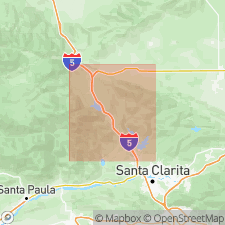
- Usage in publication:
-
- Apple Canyon Sandstone Member
- Modifications:
-
- Named
- Biostratigraphic dating
- AAPG geologic province:
-
- Los Angeles basin
Summary:
Unit is named the Apple Canyon Sandstone Member of the Ridge Route Formation of the Ridge Basin Group in the central Ridge basin, Los Angeles Co., CA. Is the uppermost of five major clastic tongues in the Ridge Route and consists of light-brown medium-grained, arkosic sandstone interbedded with mudstone and conglomerate and minor amounts of limestone; contains freshwater mollusk, ostracode, stromatolite, plant, and vertebrate fossils. Lateral extent is 8000 m; interfinger and the Posey Canyon Shale Member (new) and the Alamos Canyon Siltstone Member (new), both of the redefined Peace Valley Formation, to the northeast, and the Violin Breccia to the southwest. Conformably underlies the Hungry Valley Formation of the Ridge Basin Group. Thickness is 1000 m at type section and attains 1130 m. Age is late Miocene (Hemphillian) based on fossils [vertebrates; Kinsey Ranch fauna). (B1565)
Source: GNU records (USGS DDS-6; Menlo GNULEX).
For more information, please contact Nancy Stamm, Geologic Names Committee Secretary.
Asterisk (*) indicates published by U.S. Geological Survey authors.
"No current usage" (†) implies that a name has been abandoned or has fallen into disuse. Former usage and, if known, replacement name given in parentheses ( ).
Slash (/) indicates name conflicts with nomenclatural guidelines (CSN, 1933; ACSN, 1961, 1970; NACSN, 1983, 2005, 2021). May be explained within brackets ([ ]).

